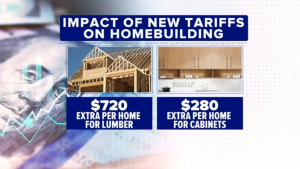ABC11: “A new report says the additional tariffs could add another $1,000 to the price of building a new home”
CNN: “One thing furniture tariffs will do, executives say, is add to the cost of living.”
As new Whatley-backed tariffs on lumber and furniture go into effect, North Carolina’s furniture industry and working families will pay the price. The tariffs could “threaten what’s left of” the furniture industry, and customers will be the “biggest losers” as companies are forced to “jack up prices.”
DC insider Michael Whatley has championed the chaotic trade war. Even as the tariffs threaten to drive up costs, Whatley has called them “record setting in terms of […] effectiveness” and has supported them “wholeheartedly.”
ABC11: As new tariffs take effect, US consumers footing more than half the burden
October 14, 2025

- “New tariffs go into effect today, threatening to increase the cost of homebuilding and renovation projects. A new report says the additional tariffs could add another $1,000 to the price of building a new home, on top of the $8,000 in tariff costs already seen this year.”
CNN: In America’s furniture capital, a mix of hope and fear as tariffs arrive
Matt Egan, Dianne Gallagher | October 14, 2025
- Furniture executives warn that importers will be hit hard by the furniture tariffs on top of existing tariffs.
- Jofran, a Massachusetts-based company that imports 100% of its products, has already been slammed by Trump’s steel tariffs and country-specific tariffs on key sources of manufacturing like Vietnam, Indonesia and India.
- The company has been forced to jack up prices and lay off workers. It has let go of about 20% of its workforce — its biggest layoffs since the 2008 financial crisis.
- Miranda notes that the entire furniture ecosystem involves American citizens who could be hurt by tariffs — everyone from the longshoremen at the ports where imports arrive, to the truck drivers, warehouse workers and store employees.
- One thing furniture tariffs will do, executives say, is add to the cost of living.
- Imported furniture is likely to get more expensive. But prices could also rise for domestic items if US manufacturers’ labor costs rise in order to attract the necessary workers to produce more in America.
- “You can’t eat all of this and stay in business. It’s got to give somewhere,” Caroline Hipple, a furniture industry consultant and former CEO, told CNN. “Someone is paying for it — and I guarantee you it’s the damn customer. That’s who the biggest losers will be. And that’s going to hurt demand, so we all suffer.”
- Furniture prices have already been rising sharply.
- In August, furniture and bedding prices were up 4.7% year-over-year, according to the Bureau of Labor Statistics. That’s the biggest 12-month increase since December 2022.
- In particular, living room, kitchen and dining room furniture prices were up 9.5%, the most since November 2022.
Paige Masten | October 2, 2025
- There are a few problems. For one, it’s not realistic to expect companies to suddenly shift operations back to the U.S. There are some furniture companies that already produce domestically and may be able to ramp up that production relatively quickly. But there are also plenty of companies that don’t, and even if they can afford to significantly scale up domestic production, building up the factories and workforce required to do that is a process that can take years. And if tariffs hurt their business in the meantime, they might not survive long enough to even make that pivot.
- There’s also the fact that Trump’s other tariffs create supply chain issues. Even companies that do make their furniture in the U.S. often source raw materials and parts globally, which are now subject to their own tariffs as well. That will make domestic production more expensive and more difficult, at least until lumber and steel suppliers can ramp up their U.S. production. Companies will eventually have to pass those price hikes down to consumers, who may not be willing to pay more for furniture if it’s not an immediate need.
- And what about the furniture that North Carolina currently exports? According to the Economic Development Partnership of North Carolina, our state exports nearly $300 million worth of furniture each year, which could decrease if other countries introduce retaliatory tariffs and no longer import as many U.S. goods.
- Using tariffs as a tool for economic revitalization is a short-sighted, knee-jerk strategy. You can’t tariff life back into an industry — but you can make investments that will help you keep up with change. North Carolina’s furniture industry isn’t the same as it used to be, but it still exists — hundreds of manufacturers support tens of thousands of jobs and generate billions of dollars in revenue. Trump may think tariffs will revive the industry, but it’s more likely that they’ll threaten what’s left of it.
###